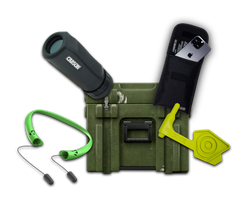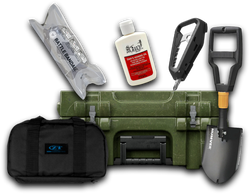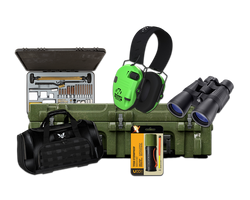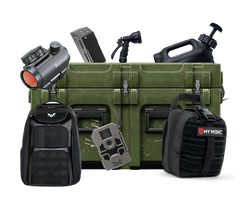How to Breathe in a Gas Mask: Essential Techniques for Safety and Preparedness
Table of Contents
- Introduction
- Overview of Gas Masks and Their Importance
- Key Components of a Gas Mask
- Importance of Fit and Seal
- Techniques for Breathing in a Gas Mask
- Common Mistakes and How to Avoid Them
- Additional Tips for Gas Mask Preparedness
- Conclusion
- FAQ Section
Introduction
Imagine being in a situation where toxic gases or hazardous materials are airborne, and a gas mask is your only line of defense. Whether it’s during a natural disaster, a chemical spill, or a military operation, knowing how to effectively breathe in a gas mask can be a life-saving skill. In these moments, the proper use of a gas mask becomes critical, yet many individuals remain unaware of the techniques that ensure its effectiveness. This blog post aims to equip you with essential knowledge on how to breathe in a gas mask, covering its significance, the mechanics of gas masks, and practical techniques to enhance your experience while wearing one.
Understanding how to breathe in a gas mask is not just for military personnel or first responders; it can benefit anyone who values personal safety and preparedness. With increasing awareness of environmental hazards and the potential for chemical threats, being educated on this subject is increasingly relevant. Throughout this article, you will learn about the components of a gas mask, the importance of proper fit and seal, and the techniques that will help you breathe comfortably and effectively.
The purpose of this blog post is to provide a comprehensive guide on how to breathe in a gas mask, alongside practical tips to maximize its efficiency. By the end of this article, you will not only understand the importance of gas masks but also possess actionable strategies to ensure your breathing remains steady even in high-stress situations.
What to Expect
As we delve into the topic, this post will be divided into several sections, including:
- Overview of Gas Masks and Their Importance
- Key Components of a Gas Mask
- Importance of Fit and Seal
- Techniques for Breathing in a Gas Mask
- Common Mistakes and How to Avoid Them
- Additional Tips for Gas Mask Preparedness
- Conclusion and Call to Action
- FAQ Section
By synthesizing this information, we aim to create a thorough understanding of how to breathe effectively in a gas mask while underscoring the importance of preparedness in any tactical scenario.
Overview of Gas Masks and Their Importance
Gas masks are critical tools designed to protect the wearer from inhaling harmful substances in the air, such as chemical agents, biological agents, and other toxic particles. These masks have been used for centuries, evolving significantly from their initial designs during World War I, where they were primarily utilized to combat the effects of chemical warfare.
Today, gas masks serve an essential role in various fields, including military operations, first responders, and civilian use during emergencies. The ability to breathe safely while wearing a gas mask can mean the difference between life and death in hazardous conditions. This makes understanding how to use and breathe in a gas mask crucial for anyone who might find themselves in such scenarios.
Gas masks work by filtering out harmful particles from the air, but their effectiveness relies heavily on the user following specific protocols. This includes ensuring the mask fits properly, understanding the breathing mechanics involved, and being aware of how to react in high-stress situations.
Key Components of a Gas Mask
To effectively use a gas mask, it is essential to understand its components and how they work together to provide protection. Here are the primary parts of a gas mask:
-
Facepiece: The main part of the gas mask that covers the face, including the eyes, nose, and mouth. It is often made from durable materials that can withstand various environmental conditions.
-
Filters/Cartridges: These are crucial components that trap harmful particles, chemicals, and biological agents. Filters can vary based on the type of threat, and it’s vital to select the right one for specific environments.
-
Straps: The straps secure the mask to the user’s face, ensuring a tight seal. Proper adjustment of the straps is critical to prevent any gaps that may allow contaminated air to enter.
-
Exhalation Valve: This allows exhaled air to escape from the mask without letting outside air in. A properly functioning exhalation valve is essential for comfortable breathing.
-
Inhalation Valve: This component allows air to be drawn in through the filter when the wearer inhales. It must be sealed correctly to ensure that only filtered air is inhaled.
-
Visor: Some gas masks come with a visor to protect the eyes from harmful substances. This can be a critical feature during exposure to chemical irritants.
Understanding these components not only helps in choosing the right gas mask but also prepares the user for effective operation.
Importance of Fit and Seal
A gas mask is only as effective as its fit. Achieving a proper seal is paramount for ensuring safety, as any gaps can allow unfiltered air to enter the mask, negating its protective capabilities. Here are key points related to fit and seal:
-
Sizing: Gas masks come in various sizes, and it’s essential to select one that fits your face shape. Some manufacturers provide adjustable features to accommodate different facial structures.
-
Testing the Seal: Before relying on a gas mask, it is advisable to perform a seal test. This can usually be done by placing the mask on your face and inhaling sharply. If the mask pulls tightly against your face without any air leaks, it indicates a good seal.
-
Regular Maintenance: Over time, masks may become less effective due to wear and tear. Regularly checking and replacing filters, inspecting for cracks, and ensuring straps are intact is essential for maintaining a proper fit.
-
Facial Hair Considerations: Beards and mustaches can interfere with the mask's ability to seal correctly. Those who wear facial hair should consider the implications for safety and may need to adjust their grooming habits accordingly.
A good fit and seal are the foundation of effective gas mask use, impacting both comfort and safety.
Techniques for Breathing in a Gas Mask
Now that we understand the components of a gas mask and the importance of fit, let's explore techniques for breathing effectively while wearing one. Proper breathing techniques can significantly enhance the overall experience and ensure that the wearer receives adequate airflow even under stressful conditions.
1. Calm Your Breathing
When wearing a gas mask, your body may instinctively react with anxiety, leading to rapid or shallow breathing. To counter this, focus on calming your breath:
-
Take Deep Breaths: Inhale deeply through your nose, allowing your diaphragm to expand. This technique maximizes the air you take in and can help calm nerves.
-
Exhale Slowly: Release the air slowly through your mouth. This prevents hyperventilation and helps maintain a steady rhythm in your breathing.
2. Practice Breathing Exercises
Before needing to wear a gas mask in a real-life scenario, practice breathing exercises while wearing the mask. This helps your body acclimate to the sensation of breathing through the filter and can reduce anxiety when the time comes.
-
Box Breathing: Inhale for a count of four, hold for four, exhale for four, and hold again for four. Repeat this cycle to establish a calm and controlled breathing pattern.
-
Alternate Nostril Breathing: If your mask allows for it, practice alternating nostril breathing to help regulate your breath and reduce tension.
3. Maintain Posture
Your posture can significantly impact your breathing efficiency. Keep your back straight and shoulders relaxed to allow for optimal lung expansion. Avoid slouching, as this can constrict your chest and make breathing more difficult.
4. Use Your Diaphragm
Focus on diaphragmatic breathing, which uses the diaphragm rather than the chest for breathing. This method is more efficient and allows for deeper inhalation:
-
Place one hand on your chest and the other on your abdomen. As you breathe in, the hand on your abdomen should rise while the hand on your chest remains relatively still.
-
This method can enhance airflow and make breathing more comfortable while wearing a gas mask.
5. Stay Hydrated and Take Breaks
If you find yourself in a situation where wearing a gas mask is necessary for an extended period, ensure you stay hydrated. Dehydration can lead to feelings of dizziness or fatigue, which may affect your ability to breathe comfortably.
If possible, take breaks in a safe environment to allow your body to relax and breathe without the mask when conditions permit.
Common Mistakes and How to Avoid Them
While learning how to breathe in a gas mask, it is essential to recognize common pitfalls that can hinder effectiveness. Here are some mistakes to avoid:
1. Ignoring the Fit
As mentioned earlier, a poor fit can lead to exposure to harmful substances. Always test the fit before relying on the mask in any situation.
2. Neglecting Maintenance
Failure to maintain the gas mask can lead to reduced effectiveness. Regularly inspect and replace filters as needed, and store the mask in a clean, dry place.
3. Panicking Under Pressure
In a high-stress environment, it is easy to panic. Remember to practice calming techniques and focus on your breathing to manage anxiety effectively.
4. Not Practicing in Advance
Many individuals fail to practice using their gas masks before an emergency arises. Conduct drills in a controlled environment to ensure familiarity with how to wear and breathe effectively.
5. Overlooking Environmental Factors
Be aware of the environment you are in. Extreme heat or physical exertion can affect your breathing, even with a gas mask. Take these factors into account and adjust your techniques accordingly.
Additional Tips for Gas Mask Preparedness
Preparation goes beyond just knowing how to breathe in a gas mask. Here are some additional tips to enhance your readiness:
1. Stay Informed
Stay updated on potential hazards in your area and the types of gas masks that are most effective against specific threats. Knowledge is power when it comes to preparedness.
2. Invest in Quality Gear
Consider investing in high-quality gas masks and filters. Crate Club offers a range of tactical gear, including gas masks, that have been tested for reliability and effectiveness. Check out their Crate Club Shop for options that suit your needs.
3. Build a Survival Kit
Alongside your gas mask, build a comprehensive survival kit that includes essential tools and equipment. Crate Club’s subscription service provides monthly delivery of curated tactical gear, ensuring you’re always prepared. Explore their Crate Club Subscription Services to enhance your preparedness.
4. Participate in Training
Seek out training opportunities to learn more about emergency preparedness and effective use of tactical gear. Engaging with the community can provide valuable insights and skills.
5. Practice Regularly
Make it a habit to practice wearing your gas mask and employing the breathing techniques discussed. Familiarity will help reduce anxiety and improve your overall effectiveness when it counts.
Conclusion
Understanding how to breathe in a gas mask is a vital skill that can save lives in emergency situations. By mastering the techniques discussed in this guide, from maintaining a proper fit to utilizing effective breathing strategies, you can enhance your readiness for any potential threat.
As you reflect on the importance of gas masks and preparedness, consider engaging with the Crate Club community and exploring their offerings. With the right knowledge and quality gear, you can ensure your safety and that of those around you in times of uncertainty.
FAQ Section
1. What should I do if my gas mask is uncomfortable?
If your gas mask is uncomfortable, check the fit to ensure it is properly adjusted. Pay attention to the straps and ensure that the mask is not too tight or too loose. If discomfort persists, consider trying a different model that better suits your facial structure.
2. How often should I replace the filters in my gas mask?
Filters should be replaced according to the manufacturer's guidelines, which typically depend on usage and exposure conditions. Regularly inspect filters for wear and replace them if they show signs of damage or reduced effectiveness.
3. Can I wear a gas mask with facial hair?
Facial hair can interfere with the mask's ability to create a proper seal. If you must wear a gas mask, consider trimming your facial hair to ensure a secure fit, or consult with your local guidelines for recommendations.
4. What should I do if I start to feel dizzy while wearing a gas mask?
If you begin to feel dizzy, try to remain calm and breathe deeply. If possible, remove the gas mask in a safe environment. Ensure you stay hydrated and take breaks when needed.
5. Are there specific gas masks recommended for civilian use?
Yes, there are several gas masks designed specifically for civilian use. Look for masks that have been tested for effectiveness against common threats, and consider consulting reputable sources, like Crate Club, for recommendations.
By following the insights in this article, you are one step closer to mastering the art of breathing in a gas mask and ensuring your safety in any situation. Remember, preparedness is not just about having the right gear; it’s about understanding how to use that gear effectively.
Share this article



